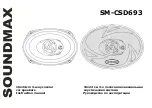
L-ACOUSTICS MTD Manual V1.2 11/30/2004
46
5.7 STAGE MONITORING
Given the optimum signal processing and protection provided by their respective LLC analog
controllers and due to their compact, wedge-shaped format and axi-symmetrical directivity, MTD
enclosures provide a high performance, “plug and play” stage monitoring solution.
FLOOR MONITORING
For floor monitoring applications, the coaxial component configuration employed in the MTD108a,
MTD112b and MTD115b provides a high degree of image and coverage stability. The benefits of axi-
symmetric directivity are even more apparent since the performer is in close physical proximity to the
enclosure and experiences a generous, homogeneous coverage pattern without the subjective
impression (and potential feedback problems) of listening to a separate horn / woofer combination.
The MONITOR setting for the LLC analog controller is intended for floor monitoring applications
since this setting features reduced low frequency shelving equalization in order to compensate for the
effects of half-space loading conditions. The X-OVER setting implements a 100 Hz high pass filter and
can also be used for speech reinforcement applications.
When using MTD enclosures in pairs for floor monitoring, the same principles apply as for overhead
or distributed front fill systems, i.e., the optimum spacing between floor monitors will depend on the
coverage angle of the enclosure (100, 85 and 85 degrees for MTD108a, MTD112b and MTD115b,
respectively) and the throw distance to the performing artist (which is determined by the floor
monitor angle with respect to vertical and the artist’s height). Center-to-center overlap will provide
the most uniform coverage and as a guideline, nominal monitor distance plus monitor separation is
tabulated below in Table 16.
Apart from separation and distance to the performer, the last issue to consider when using MTD108a,
MTD112b or MTD115b as floor monitors in paired configurations is whether to angle the enclosures
in towards the performer. Although it looks more “rock and roll” and gives the performer the
impression of having more SPL, it is generally not advised to angle wedges in but to use them with the
front faces parallel to each other. Essentially, angling in wedges no longer provides optimum center-
to-center overlap and results in too much overlap. Due to this excessive overlap there will be a
cancellation loss of up to 8 dB in the high end (above 6 kHz, approximately) that will need to be
compensated for via output gain adjustment and/or equalization. Ultimately, it all comes down to artist
preference and what you’re shooting for in a monitor mix but if you want optimum coverage and
nominally flat, follow the spacing/distance recommendations given in Table 16 and don’t angle the
wedges in.
Содержание MTD Series
Страница 1: ...Version 1 2 December 2004 L ACOUSTICS MTD LINE MTD108a MTD112b MTD115b OPERATOR MANUAL ...
Страница 3: ...L ACOUSTICS MTD Manual V1 2 11 30 2004 2 ...
Страница 11: ...L ACOUSTICS MTD Manual V1 2 11 30 2004 10 MTD108 LLCa front MTD108 LLCa rear LLC112b st front LLC112b st rear ...
Страница 58: ...L ACOUSTICS MTD Manual V1 2 30 11 04 57 Figure 30 MTD108a line drawing ...
Страница 59: ...L ACOUSTICS MTD Manual V1 2 30 11 04 58 Figure 31 MTD108a plus ETR8 line drawings ...
Страница 62: ...L ACOUSTICS MTD Manual V1 2 30 11 04 61 Figure 32 MTD112b line drawing ...
Страница 63: ...L ACOUSTICS MTD Manual V1 2 30 11 04 62 Figure 33 MTD112b plus ETR1 line drawings ...
Страница 66: ...L ACOUSTICS MTD Manual V1 2 30 11 04 65 Figure 34 MTD115b line drawing ...
Страница 67: ...L ACOUSTICS MTD Manual V1 2 30 11 04 66 Figure 35 MTD115b plus ETR2 line drawings ...
















































